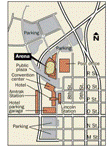Community and Regional Planning Program
Date of this Version
2016
Citation
The International Archives of the Photogrammetry, Remote Sensing and Spatial Information Sciences, Volume XLI-B3, 2016 XXIII ISPRS Congress, 12–19 July 2016, Prague, Czech Republic
doi:10.5194/isprsarchives-XLI-B3-849-2016
Abstract
The Zoige wetland is the largest alpine peat wetland in China, and it has been degrading since 1960s. MODIS Enhance Vegetation Index (EVI) and Land Surface Temperature (LST) products in late august from 2000 to 2014 were employed to explore vegetation index and land surface temperature change tendency and to perform Temperature Vegetation Dryness Index (TVDI). The correlation between the annual mean of EVI and annual mean of LST was also calculated at pixel scale. The main purpose of this study is to explore the relationship between wetland degradation and climate change. The main conclusions are as follows: (1) Average EVI in Zoige plateau tended to be decreasing from 2000 to 2014, especially after 2007. In wetland areas, the annual mean of EVI were negative, while the slope were positive. It showed that the water storage of wetlands in Zoige plateau had been decreasing in the past 15 years and will keep decreasing in the future. (2) Overall, LST in the whole Zoige plateau had been increasing since 2000. While the minimum TVDI increased from 2000 to 2008 and then decreased. The change of TVDI suggested that drought should be a main factor that lead to wetland degradation in Zoige. (3) The uneven distribution of the correlation between EVI and LST suggested that LST is also one of the main reasons of wetland degradation.

